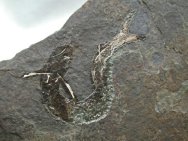Acanthodes gracilis
Phylum Chordata, Class Acanthodii, Order Acanthodiformes
Geologic Time: Early Permian (~290 million years ago)
Size: 75 mm in length
Fossil Site: Rotliegendes, ( Red Beds), Rockenhausen, Germany
 The
Acanthodians are jaw-bearing fish that still are the subject of dispute
over their systematic position because they have features of both bony
fish ( Osteichthyes) and cartilaginous fish (Chondrichthyes). They possess
highly advanced, spindle-shaped bodies thought to have made them swift
swimmers. The body was covered in small mosaic-like scales. They possessed
small teeth that were typically confined to Acanthodesthe lower jaw;
some were toothless. The feature they all share in common is the fact
that massive spines formed of dentine support all fins other than the
caudal fins. Indeed, the name Acanthodii is derived from the Greek word
for spine.
The
Acanthodians are jaw-bearing fish that still are the subject of dispute
over their systematic position because they have features of both bony
fish ( Osteichthyes) and cartilaginous fish (Chondrichthyes). They possess
highly advanced, spindle-shaped bodies thought to have made them swift
swimmers. The body was covered in small mosaic-like scales. They possessed
small teeth that were typically confined to Acanthodesthe lower jaw;
some were toothless. The feature they all share in common is the fact
that massive spines formed of dentine support all fins other than the
caudal fins. Indeed, the name Acanthodii is derived from the Greek word
for spine.
The oldest acanthodian lived during the late Ordovicain. They reached their peak during the Devonian, and became extinct during the Great Dying of the end-Permian extinction. This well-preserved example is known as Acanthodes gracilis, the patronymic genus. The genus died out in the lower Permian. As is typical, the most prominent feature to be seen here are the diagnostic spines; the body contours have been highlighted by the preparator to make viewing easier
RGP111030